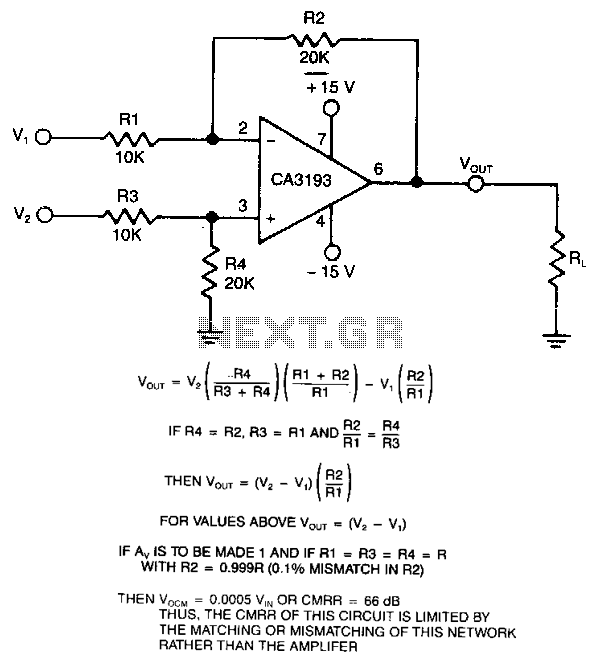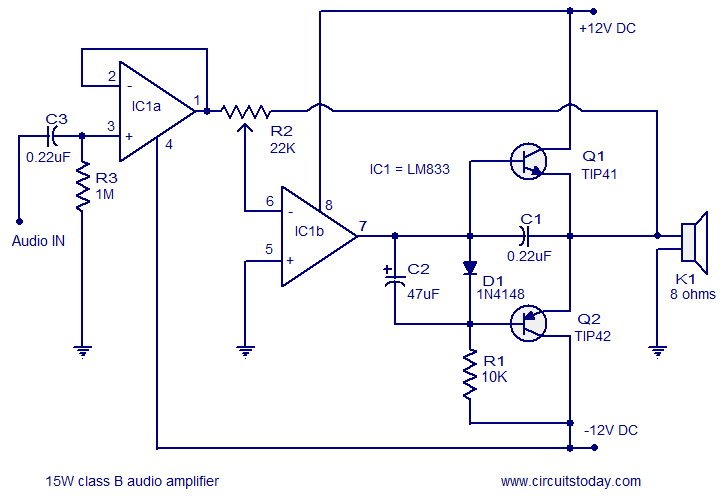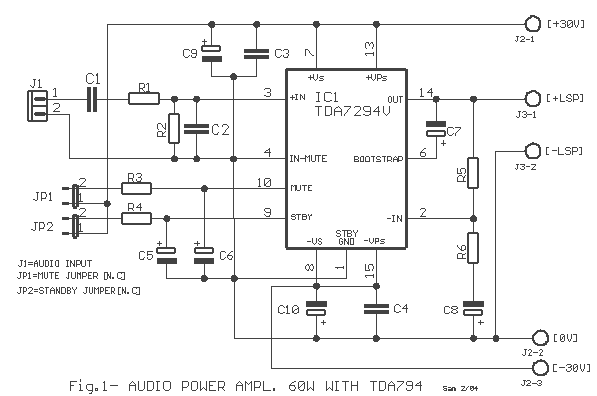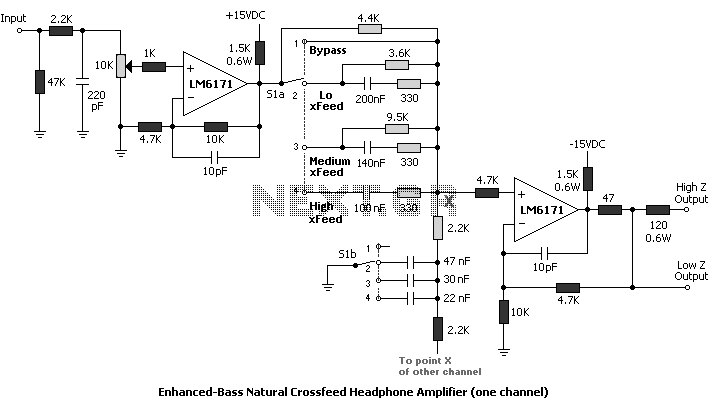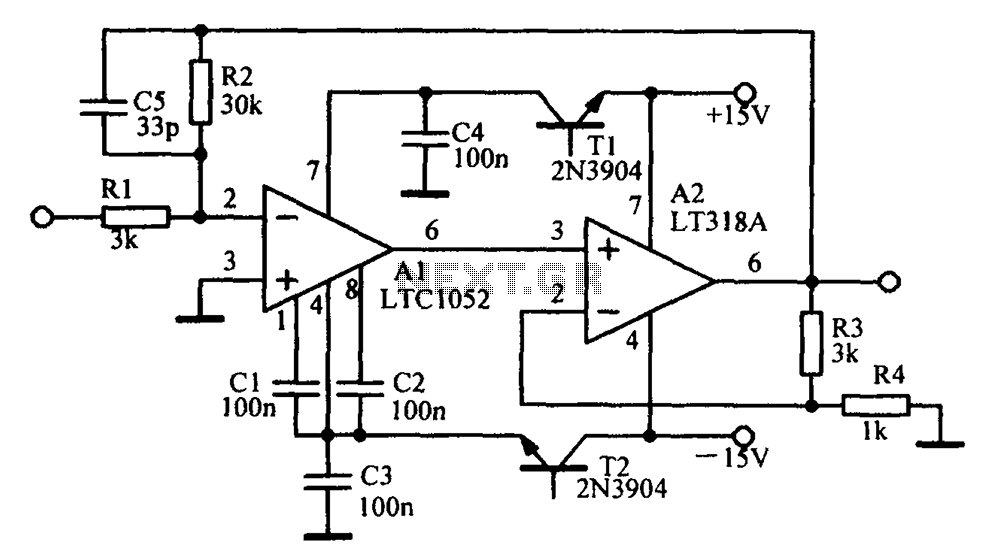
video distibution amplifier with five
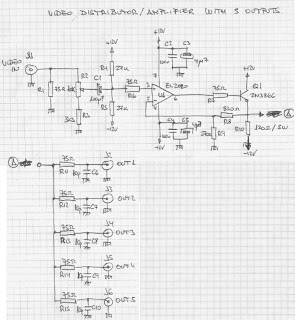
The circuit presented here has numerous applications. Essentially, the distribution amplifier receives a composite video signal from a video player (VCR) or a video generator (analog output) and buffers it, allowing it to be simultaneously sent to up to five different video equipment inputs, such as monitors, TV sets, and additional VCRs. For instance, in a hall, the image generated by a central DVD player can be displayed on five different TV screens, with the audio being reproduced through a separate amplifier. The circuit utilizes the EL2020 (or a similar) operational amplifier, characterized by a high bandwidth. The EL2020 amplifies the video signal at the input stage with a gain adjustment range of ±6 dB. The output transistor Q1, a 2N3866, delivers the video signal to the five outputs, which are designed to drive loads with a 75-ohm impedance.
The described distribution amplifier circuit is designed to enhance the versatility of video signal distribution in various settings, such as auditoriums, classrooms, or home theaters. By utilizing the EL2020 operational amplifier, the circuit ensures high fidelity and minimal distortion in the video signal, allowing for clear and vibrant images on multiple displays. The operational amplifier's bandwidth is crucial for maintaining signal integrity, especially when dealing with composite video signals, which can be sensitive to degradation.
The gain adjustment capability of ±6 dB provides flexibility in managing the output signal level, accommodating different types of video equipment that may have varying input sensitivities. This feature is particularly useful in environments where the distance between the distribution amplifier and the connected devices can lead to signal loss or attenuation.
The choice of the 2N3866 transistor for output buffering is significant, as it is capable of handling the required current and voltage levels while maintaining the integrity of the video signal. The design ensures that each of the five outputs can drive a 75-ohm load, which is the standard impedance for most video equipment, ensuring compatibility and optimal performance.
Overall, this circuit serves as an effective solution for distributing composite video signals across multiple devices, enhancing the viewing experience in any application where multiple screens are utilized.The circuit shown here should have a lot of applications. Basically, the distribution amplifier takes the composite video signal from a video player (VCR) or a video generator (analogue output) and buffers it in such a way that it can be simultaneously applied to up to five different video equipment inputs, like monitors, TV sets, other VCRs and so on. For example, in a hall, the image produced by a central DVD player can be shown on five different TV screens with the sound reproduced through a separate amplifier. The circuit is based on the type EL2020 (or similar) operational amplifier which is marled by large bandwidth.
The LL2020 amplifies the video signal applied to the input stage, with a gain adjustment range of ±6 dB. Output transistor Q1, a 2N3866, applies the video signal to the five outputs designed to drive loads with 75- © impedance.
🔗 External reference
The described distribution amplifier circuit is designed to enhance the versatility of video signal distribution in various settings, such as auditoriums, classrooms, or home theaters. By utilizing the EL2020 operational amplifier, the circuit ensures high fidelity and minimal distortion in the video signal, allowing for clear and vibrant images on multiple displays. The operational amplifier's bandwidth is crucial for maintaining signal integrity, especially when dealing with composite video signals, which can be sensitive to degradation.
The gain adjustment capability of ±6 dB provides flexibility in managing the output signal level, accommodating different types of video equipment that may have varying input sensitivities. This feature is particularly useful in environments where the distance between the distribution amplifier and the connected devices can lead to signal loss or attenuation.
The choice of the 2N3866 transistor for output buffering is significant, as it is capable of handling the required current and voltage levels while maintaining the integrity of the video signal. The design ensures that each of the five outputs can drive a 75-ohm load, which is the standard impedance for most video equipment, ensuring compatibility and optimal performance.
Overall, this circuit serves as an effective solution for distributing composite video signals across multiple devices, enhancing the viewing experience in any application where multiple screens are utilized.The circuit shown here should have a lot of applications. Basically, the distribution amplifier takes the composite video signal from a video player (VCR) or a video generator (analogue output) and buffers it in such a way that it can be simultaneously applied to up to five different video equipment inputs, like monitors, TV sets, other VCRs and so on. For example, in a hall, the image produced by a central DVD player can be shown on five different TV screens with the sound reproduced through a separate amplifier. The circuit is based on the type EL2020 (or similar) operational amplifier which is marled by large bandwidth.
The LL2020 amplifies the video signal applied to the input stage, with a gain adjustment range of ±6 dB. Output transistor Q1, a 2N3866, applies the video signal to the five outputs designed to drive loads with 75- © impedance.
🔗 External reference
Warning: include(partials/cookie-banner.php): Failed to open stream: Permission denied in /var/www/html/nextgr/view-circuit.php on line 713
Warning: include(): Failed opening 'partials/cookie-banner.php' for inclusion (include_path='.:/usr/share/php') in /var/www/html/nextgr/view-circuit.php on line 713
